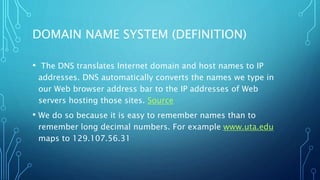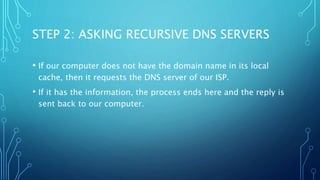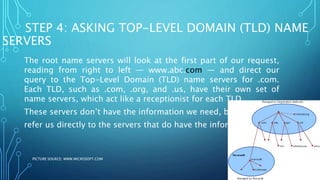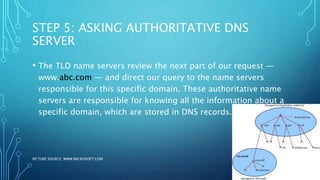Domain Name System
- 1. HOW DOMAIN NAME SYSTEM WORKS By: Gurkamal Deep Singh Rakhra gurkamaldeep@live.com
- 2. CONTENTS âĒ Definition âĒ Devices involved âĒ Working âĒ Demo
- 3. DOMAIN NAME SYSTEM (DEFINITION) âĒ The DNS translates Internet domain and host names to IP addresses. DNS automatically converts the names we type in our Web browser address bar to the IP addresses of Web servers hosting those sites. Source âĒ We do so because it is easy to remember names than to remember long decimal numbers. For example www.uta.edu maps to 129.107.56.31
- 4. DEVICES INVOLVED âĒ DNS Server (it translates easily memorized domain names to the numerical IP addresses needed for the purpose of locating computer services and devices worldwide). âĒ Laptop/PC/mobile phone etc. âĒ Main server hosting the site.
- 5. WORKING
- 6. STEP 1: REQUESTING INFORMATION âĒ When we enter the URL in the web browser, the first place our computer looks is its local DNS cache, which stores information that our computer has recently retrieved. âĒ If our computer doesnât already have it, it needs to perform a DNS query to find out.
- 7. STEP 2: ASKING RECURSIVE DNS SERVERS âĒ If our computer does not have the domain name in its local cache, then it requests the DNS server of our ISP. âĒ If it has the information, the process ends here and the reply is sent back to our computer.
- 8. STEP 3: ASKING ROOT NAME SERVER âĒ If DNS server does not have the information, then it asks Root Name servers. âĒ A name server is a computer that answers questions about domain names, such as IP addresses. They can direct our query to someone that knows where to find it.
- 9. STEP 4: ASKING TOP-LEVEL DOMAIN (TLD) NAME SERVERS The root name servers will look at the first part of our request, reading from right to left â www.abc.com â and direct our query to the Top-Level Domain (TLD) name servers for .com. Each TLD, such as .com, .org, and .us, have their own set of name servers, which act like a receptionist for each TLD. These servers donât have the information we need, but they can refer us directly to the servers that do have the information. PICTURE SOURCE: WWW.MICROSOFT.COM
- 10. STEP 5: ASKING AUTHORITATIVE DNS SERVER âĒ The TLD name servers review the next part of our request â www.abc.com â and direct our query to the name servers responsible for this specific domain. These authoritative name servers are responsible for knowing all the information about a specific domain, which are stored in DNS records. PICTURE SOURCE: WWW.MICROSOFT.COM
- 11. STEP 6: RETRIEVING THE RECORD âĒ The recursive server retrieves the record for abc.com from the authoritative name servers and stores the record in its local cache. If anyone else requests the host record for abc.com, the recursive servers will already have the answer and will not need to go through the lookup process again. All records have a time-to-live(TTL) value, which is like an expiration date.
- 12. STEP 7: RECEIVING THE REPLY âĒ Recursive server returns the record back to your computer. Our computer stores the record in its cache, reads the IP address from the record, then passes this information to the browser. The browser then opens a connection to the webserver and receives the website.
- 13. FLOW DIAGRAM User Recursive DNS server Root Name Server TLD Name Server Authoritative Server
- 14. THE WHOLE PROCESS TAKES ONLY MILLISECONDS TO COMPLETE.
- 15. DEMO
- 16. 3. Thatâs in my cache. It maps to this IP: 129.107.56.31 4. Great Iâll cache it for some time in case I get more requests. 1. I need directions to www.uta.edu DNS Server DNS Server 5. Thank you.
















